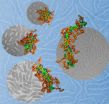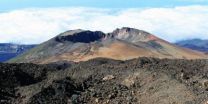(Press-News.org) Researchers at the University of Illinois Hospital & Health Sciences System have identified a genetic signature that distinguishes patients with complicated sarcoidosis, an inflammatory lung disease that can be fatal, from patients with a more benign form of the disease. The gene signature could become the basis for a simple blood test.
Their findings are reported online in the journal PLOS ONE.
In sarcoidosis, tiny clumps of abnormal tissue form in organs of the body. These clusters of immune cells, called granulomas, cause inflammation. Sarcoidosis can occur in the lymph nodes, liver, eyes, skin or other tissues, but almost always also in the lungs. The cause of the disease is unknown. African Americans are at higher risk for the disease and for more severe cases.
"One of the perplexing aspects of this disease is that two thirds of the people who get sarcoidosis get better with only minimal therapy," says Dr. Joe G.N. "Skip" Garcia, vice president for health affairs at the University of Illinois and principle investigator on the study.
But one third of patients go on to develop complicated sarcoidosis -- neurologic sarcoidosis, cardiac sarcoidosis and progressive lung disease, Garcia said. Complicated sarcoidosis can leave patients with lung damage, and in a small percentage of cases the disease can be fatal.
The challenge, Garcia says, is that there is no difference in the clinical presentation between patients with simple sarcoidosis and those who will go on to develop more serious disease.
The researchers took blood from patients with simple and complicated sarcoidosis as well as patients without the disease to look for a pattern of gene expression unique to complicated sarcoidosis.
They were able to identify a distinct 20-gene pattern of gene expression that could reliably identify those most likely to progress to complicated sarcoidosis.
A 31-gene expression signature had been identified previously, but a smaller panel of genes makes the new test less expensive and more useful clinically, said Garcia.
"We are dedicated to looking for new insights as well as new therapies for sarcoidosis and hope to someday be able to identify people at risk for it ahead of time," Garcia said.
UI Health has partnered with the Bernie Mac Foundation to form the Bernie Mac Star Clinic for Sarcoidosis, where the researchers hope to further validate use of the genetic signature.
They hope the genetic signature could someday be the basis for a biochip that could identify patients most likely to progress to life-threatening disease.
### The study was supported by NIH grants NHLBI HL58094, RO1HL112051, HL68019, HL83870, UO1HL105371-01, RC2 HL101740-01 and NHLBI K23HL098454; and by the Johns Hopkins Sarcoidosis gene bank/database and the Hospital for the Consumptives of Maryland.
Tong Zhou, research assistant professor of pulmonary, critical care and sleep medicine at the UIC College of Medicine, was first author of the paper. Wei Zhang, Dr. Nadera Sweiss, Shwu-Fan Ma, Imre Noth and Roberto Machado of the UIC College of Medicine; Edward Chen, David Moller of Johns Hopkins University; and Kenneth Knox of the University of Arizona also contributed to the study.
For more information about the University of Illinois Hospital & Health Sciences System,
visit http://www.hospital.uillinois.edu.
New gene test flags risk of serious complications in sarcoidosis
2012-10-12
ELSE PRESS RELEASES FROM THIS DATE:
Transplantation of embryonic neurons raises hope for treating brain diseases
2012-10-12
The unexpected survival of embryonic neurons transplanted into the brains of newborn mice in a series of experiments at the University of California, San Francisco (UCSF) raises hope for the possibility of using neuronal transplantation to treat diseases like Alzheimer's, epilepsy, Huntington's, Parkinson's and schizophrenia.
The experiments, described this week in the journal Nature, were not designed to test whether embryonic neuron transplants could effectively treat any specific disease. But they provide a proof-of-principle that GABA-secreting interneurons, a type ...
White construction workers in Illinois get higher workers' comp settlements: Study
2012-10-12
White non-Hispanic construction workers are awarded higher workers' compensation settlements in Illinois than Hispanic or black construction workers with similar injuries and disabilities, according to researchers at the University of Illinois at Chicago School of Public Health.
The disparity amounted to approximately $6,000 more for white non-Hispanic claimants compared to minority workers in the same industry, says Lee Friedman, assistant professor of environmental and occupational health sciences at UIC and lead author of the study, which was published in the October ...
Documented decrease in frequency of Hawaii's northeast trade winds
2012-10-12
Scientists at University of Hawaii at Manoa (UHM) have observed a decrease in the frequency of northeast trade winds and an increase in eastern trade winds over the past nearly four decades, according to a recent study published in the Journal of Geophysical Research. For example, northeast trade wind days, which occurred 291 days per year 37 years ago at the Honolulu International Airport, now only occur 210 days per year.
Jessica Garza, a Meteorology Graduate Assistant at the School of Ocean and Earth Science and Technology (SOEST) at UHM; Pao-Shin Chu, Meteorology ...
Surgery or radiation, not monitoring, most often sought for low-risk prostate cancer, Mayo finds
2012-10-12
ROCHESTER, Minn. -- Few physicians recommend active surveillance for low-risk prostate cancer rather than pursuing surgery or radiation, according to a Mayo Clinic study being presented at the North Central Section of the American Urological Association's annual meeting Oct. 10 in Chicago. Mayo Clinic urologists also are discussing findings on enlarged prostates, bladder cancer and other research and will be available to provide expert comment to journalists on others' studies.
Mayo studies being presented, and their embargo dates and times, include:
Active Surveillance ...
Scientists discover that shape matters in DNA nanoparticle therapy
2012-10-12
Researchers from Johns Hopkins and Northwestern universities have discovered how to control the shape of nanoparticles that move DNA through the body and have shown that the shapes of these carriers may make a big difference in how well they work in treating cancer and other diseases.
This study, to be published in the Oct. 12 online edition of the journal Advanced Materials, is also noteworthy because this gene therapy technique does not use a virus to carry DNA into cells. Some gene therapy efforts that rely on viruses have posed health risks.
"These nanoparticles ...
Report -- illegal hunting and trade of wildlife in savanna Africa may cause conservation crisis
2012-10-12
New York, NY and Hyderabad (India) – A new report published today by Panthera confirms that widespread illegal hunting and the bushmeat trade occur more frequently and with greater impact on wildlife populations in the Southern and Eastern savannas of Africa than previously thought, and if unaddressed could potentially cause a 'conservation crisis.' The report challenges previously held beliefs of the impact of illegal bushmeat hunting and trade in Africa with new data from experts.
While the bushmeat trade has long been recognized as a severe threat to the food resources ...
New weapons detail reveals true depth of Cuban Missile Crisis
2012-10-12
The Cuban Missile Crisis took place 50 years ago this October, when US and Soviet leaders pulled back from the very brink of nuclear war. This was the closest the world has come to nuclear war, but exactly how close has been a matter of some speculation. The conflict, itself, has been analyzed and interpreted, but the number and types of nuclear weapons that were operational have not. According to fresh analysis available today in the Bulletin of the Atomic Scientists, published by SAGE, senior experts calculate the nature of weapons capabilities on both sides, and write ...
GMES for Europe
2012-10-12
The potential of GMES for crisis management and environmental monitoring is highlighted in a new publication with users demonstrating the importance of Earth observation data to European regions.
The joint ESA-NEREUS (Network of European Regions Using Space Technologies) publication is a collection of articles that provide insight into how the Global Monitoring for Environment and Security (GMES) programme is being used in new applications and services across Europe.
The articles, prepared by regional end-users, research institutes and industry providers from 17 different ...
Development of 2 tests for rapid diagnosis of resistance to antibiotics
2012-10-12
With their excellent sensitivity and specificity, the use of these extremely efficient tests on a world-wide scale would allow us to adapt antibiotic treatments to the individual's needs and to be more successful in controlling antibiotic resistance, particularly in hospitals. These works were published in September in two international reviews:
Emerging Infectious diseases and The Journal of Clinical Microbiology.
These diagnostic tests will allow rapid identification of certain bacteria that are resistant to antibiotics and hence:
Allow us to better adapt the treatment ...
Scientists identify trigger for explosive volcanic eruptions
2012-10-12
Scientists from the University of Southampton have identified a repeating trigger for the largest explosive volcanic eruptions on Earth.
The Las Cañadas volcanic caldera on Tenerife, in the Canary Islands, has generated at least eight major eruptions during the last 700,000 years. These catastrophic events have resulted in eruption columns of over 25km high and expelled widespread pyroclastic material over 130km. By comparison, even the smallest of these eruptions expelled over 25 times more material than the 2010 eruption of Eyjafjallajökull, Iceland.
By analysing ...



